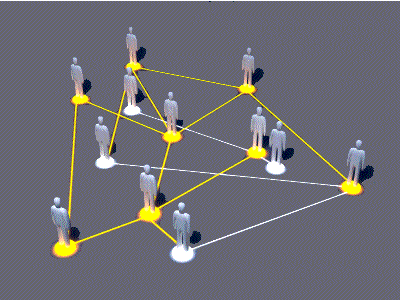- POPULAR ARTICLES
- Thank You Words
- Retirement Wishes
- Face to Face
Grapevine Communication
Grapevine communication is the informal communication network within an organization.
The grapevine is used to spread information bypassing the formal communication structure. Just like the grapevine plant: it spreads in random ways and it goes where it can.
The grapevine is formed by individuals and groups in an organization. The people in the groups have something in common that links them together.

A person can belong to one or more groups. As an example, a manager can belong to a group of women that go to lunch together every Friday. She can also belong to a group of managers in her department that talk about work in informal ways. She could have a third group of people scattered throughout the organization with which she shares other common interests outside of work.
The manager in this example is likely to pass information across her three main, informal networks. In some ways, she is verifying the accuracy of the rumors she hears. When more than one of her networks is in agreement about a given rumor, she is bound to believe it’s true.
Disadvantages of Grapevine Communication
There are some intrinsic dangers in bypassing the organizational channels to get to the facts of the matter. The main danger is that much of the information that gets spread through the grapevine is not verified. Some of the information is likely false and difficult, if not impossible, to verify.We discount information when the source is a known gossiper. But not completely... Even when the source is someone known to spread rumors, we believe that where there's smoke... Since we don’t know what part is fire and what is smoke, we accept the whole rumor. To justify our participation in spreading the rumor, we tell ourselves that part of it must be true.
The main reason why we give credence to a rumor is that it seems to match what we think about the situation or person that the rumor is about. We also tend to believe the person sharing the rumor with us.
Another main disadvantage of grapevine communication is that it's often used to spread more than rumors; it's used to spread gossip.
The terms rumors and gossip are used sometimes interchangeably, but rumors are not quite the same as gossip. Both are pieces of information that can't be verified, but rumors tend to affect organizations or groups of people, while gossip refers to more personal matters.
When gossip is being spread through the grapevine, people's reputations, careers, and lives can get destroyed very rapidly.
For a related article How Rumors Hurt People, click here.
Despite its disadvantages, the grapevine can serve a purpose.
Advantages of Grapevine Communication
Grapevine communication creates a social bond where none existed. People like to talk to one another; whether they talk about work or family, or anything. Teams become more cohesive when members talk to one another outside of the project or assignment they may be working on. Informal communication lends itself to bonding.
The grapevine fills in a gap that is left when official information is missing, especially in chaotic or changing times. Even in organizations where management is very proactive about communicating change and keeping employees informed, the grapevine helps to fill in the blanks.
The grapevine in many ways helps keep people honest; it can dissuade people from engaging on behavior that they don’t want others to know about. This is a two edge sword. On one hand, people will think twice about taking what they know is a wrong course of action. On the other hand, they may also think twice about taking a necessary risk and doing the right thing, fearful that appearances that may give rise to rumors.
Bottom Line
Grapevine communication is part of the workplace, it can't be eliminated. Recognizing its pros and cons can help you use it to your advantage.
Have A Great Story About The Grapevine at Work?
Do you have a great story about this?
Have you found other pluses or minuses of the grapevine?
Have you found others ways that people use the this informal communication network?
Share!
What Other Visitors Have Said
Click below to see contributions from other visitors to this page...
Informal Communication can be Good and Bad 




I work as a human resource manager in a MNC bank. I was handed over the responsibility of studying the behavior patterns of successful and mediocre employees …
Gossip at work can help Not rated yet
Employees that gossip at work are mostly wasting their time, but sometimes they are helping out.
I was eighteen and working in a day camp created by …
Where do you want to go next?
For additional articles about communication in the workplace, you can visit Workplace Communication




